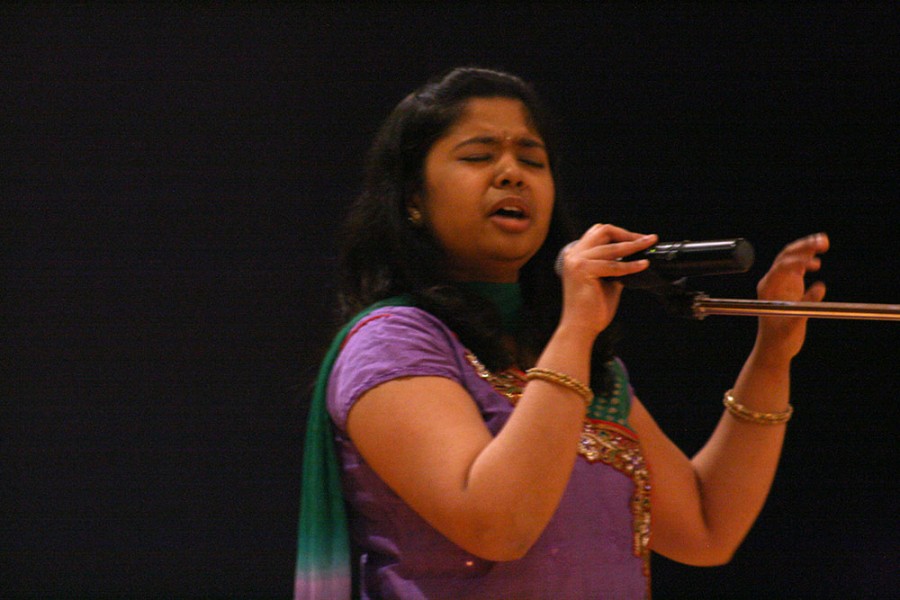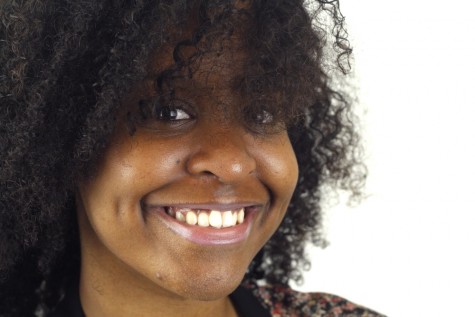‘Sounds of the World’ provides colorful outlook
Deepthi Masabdar, an engineering major, performs an Indian song during “Sounds of the World” Friday in the University Ballroom in the Martin Luther King Jr. University Union.
April 5, 2015
Pabitra Aryal, a Charleston resident, sang “Resham Firiri,” a song from her native country of Nepal. The prideful Aryal was unable to stop smiling while harmonizing her country’s song along with two others while on stage.
Venturing across the globe and back to Eastern’s Grand Ballroom was the mission for the Association of International Students’ “Sounds of the World” Friday evening.
Countries including Nepal, South Korea, India, Saudi Arabia and China offered pieces of their culture with dancing and singing.
“Resham Firiri” is a folk song from Nepal and is often heard at Nepalese events.
Aryal said music is greater than the language barrier and is something everyone in the world relates to; she also said “Sounds of the World” is a cultural exchange for anyone who is involved.
“I feel that music is a common thing we all can share, and it’s a blessing to communicate in a way like that,” Aryal said.
Students from the different cultures were encouraged to go to the dance floor and whenever they heard a song from their country they would find themselves at the center of the ballroom dancing along to the music.
Xueting Sun, a graduate student, played a traditional Chinese flute using a TaoDi, the oldest Chinese wind instrument.
“I used two flutes; one is a normal sound and the other is a higher sound,” she said.
Sun, who has been in America since last semester, said she likes the education system. She said “Sounds of the World” brings all the countries together in a diverse way.
“I like music; music makes me relax, and ‘Sounds of the World’ is all the music of the world,” Sun said, “Music (has) no boundary, no world, everybody can understand music and that’s perfect.”
When audience members first walked in the room, the association gave them black, blue or red balloons.
As the night progressed, Shifa Shamim, the president of the association, told everyone to pop their balloons and instantly the room was filled with the booming sounds.
Three numbers from the different color balloons were picked and those individuals received an Association of International Students T-shirt.
Activities including musical chairs, a cultural trivia game and a newspaper dance were played at the program.
The newspaper dance involved audience members dancing on top of a newspaper until the music stopped. When the song ended, participants folded their newspaper and continued to dance on the small sheet. The person who did not fall, received an association T-shirt.
Jaesuk Lim, the public relations chair for the association, is from South Korea and has been in the states for three months. Lim said he spent time in the military and then moved to Canada.
Lim said sometimes international students have a sense of loneliness because they are away from their families and friends.
Lim also said he is interested in public relations, and being a part of the public relations committee for the association helps him to get a hands-on feel.
Ayeshah Hussain, the treasurer for the association, said joining the association has aided her in getting back to her own culture.
“There has to be something that’s culturally diverse and I joined AIS to understand my background of being Indian,” Hussain said. “Since I moved here I got lost with it; it was a nice way to get back in touch with my culture.”
The last performance included the Saudi Club, which consisted of six members dancing to a formal Saudi dance called “Ardah” while clothed in the Shemagand and Thoeb. They followed the dance with a Saudi Arabian guitar called an Oed.
Rajasri Pingili, the organizational officer for the association, said diversity is needed in a thriving community.
She said if everyone were the same, there would be no variety. Pingili said “Sounds of the World” encourages a colorful outlook.
“If you put the same flowers in a vase it’s plain, but if you bring all the colors from all types of flowers to this vase, it will bring a different look, a different feel and that’s what all of this brings to Eastern,” Pingili said.
Pingili said when she first arrived to America she was scared because of the language barrier. She said she was not sure if people would shun her because of her accent.
“I was shy to talk to others from different countries, but we learn from a variety of cultures,” Pingili said. “Pakistan and India are complete rivals, but here we’re talking to each other, we are friendly, we help each other and that’s something.”
T’Nerra Butler can be reached at 581-2812 or [email protected].

















































